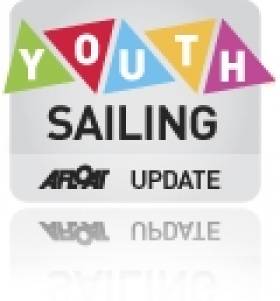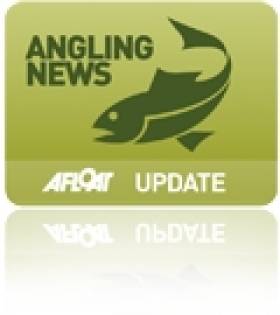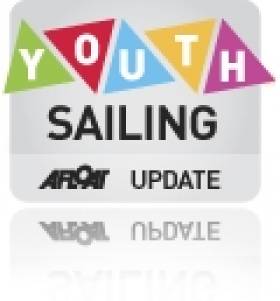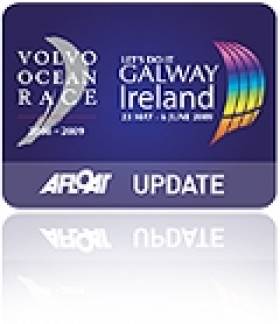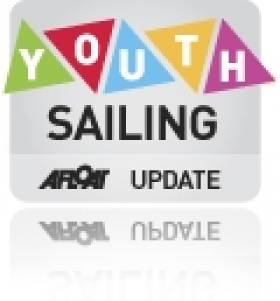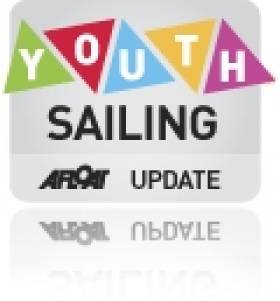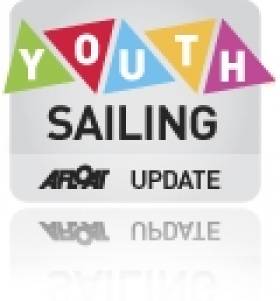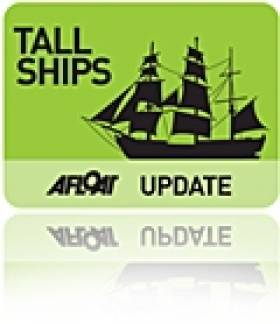Displaying items by tag: youth
Team GBR Arrival Hots up Mitsubishi Youth Event
#YOUTH NATIONALS –The GBR Youth Sailing team is showing the depth of its ambition by arriving in Dun Laoghaire a full week ahead of the Irish Mitsubishi Youth National Championships this weekend. They are part of an influx of foreign crews all intent on sampling Dublin Bay conditions before the big event, the ISAF Youth World Championships to be staged in Dun Laoghaire in July. As many as six overseas squads are expected for the Easter Week championship.
Conditions on the bay are exepcted to feature moderate to strong northerly winds and there's a chill in the air!
Preparations for the massive youth event, one of the biggest events on the Irish sailing calendar, are already in situ with the entire forecourts of the Royal St. George Yacht Club and the Irish Yacht Club of the Year, the National Yacht Club cleared to make way for up to 400 youths sailors many of whom have an eye on Irish team selection to be decided at the weekend. Up to a dozen GBR camper vans are in located on the Carlisle Pier in the centre of the venue this morning. The fleet has come directly from Wales where last week the British youth team was selected to make it the hottest ever Mitsubishi Irish Youth event.
The Dun Laoghairte event serves as part of the Irish team selection process for the world championships with just one boat per class selected.
It won't be the first time propspective Irish crews have come up against the might of the RYA team either. Some of the Irish sailors who are keen on securing their place on the Irish team were in Wales too and most of those who travelled found the going tough. There were 268 entries, six nations and 388 sailors in Wales. Other Irish sailors were in Italy recently and have reported back with good results.
Competition among the Irish crews is likely to be closest in the single-handed Laser Radial Boys, where Robbie Gilmore (Strangford Lough YC), Finn Lynch (National YC/Blessington SC) and Fionn Lyden (Baltimore SC) are in the hunt.
Lynch won the Laser Radial U17 prize recent Europa Cup held in Lake Garda, Italy including two race wins in his score. He also came fiffh overall in a fleet of 180 youth boys Radials. This qualifies Finn for the upcoming ISAFs in the overseas category but he still needs to finish top in the youth nationals.
Royal Cork's Cian Byrne also achieved an outstanding result on Lake Garda, Italy when he came second overall and second in the U16 section sailing the Laser 4.7 Rig. Travelling with the ISA national squad, Cian finished with a final race first to cap off a remarkable performance. The Europa Cup represents top class European competition and the Garda event had 160 competitors in the 4.7 class alone.
The Italian event was attended by Thomas Chaix’s Academy competing in the Laser Radial fleet. Baltimore's Fionn Lyden finished 15th.
Among the Laser Radial girls, Sophie Murphy (Quoile YC and Royal St.Georg YC) and Sian Kneafsey (National YC) seek the single place. Kneafsey also achieved her goal of part qualifying for the upcoming ISAFs in the overseas event by coming in the top 50% of eligible female Radials but no one in is in any doubt about the potency of Murphy, last year's ISAF youth rep in Croatia who inlcuded a rce win in her tally.
In the double-handed classes, Patrick Crosbie and Grattan Roberts (Royal Cork YC), Aodh Kennedy and Peter Stokes (Royal Cork YC) will be contenders for the 420 boys class. Adam Hyland and Bill Staunton travelled to Pwhelli for the GBR trial and fnished 17th from a fleet of 36.
Seán and Tadgh Donnelly from the National Yacht Club are competing for the 29er place.They placed 17th from 72 in Pwhelli.
Alex Rumball and Rory McStay (Royal St George YC/Royal Irish YC) are competing for the SL 16 catamaran selection skiff spot and finished seventh from nine in Wales.
Ireland will not be seeking slots in the available RSx windsurfer classes.
The normal selection qualification criteria has been relaxed – slightly – this year by the Olympic Steering Group, who require a top-two placing in the Irish championships plus a top 50-per-cent result at designated international events.
Meanwhile Sophie Browne of Tralee has been on top form in the international Optimist racing for the Consulate Cup in Denmark, finding an extra gear as the series progressed to emerge as overall winner. It's a signficant boost for the home team as the world squads start heading for Dublin Bay and the Mitsubishi Motors Irish Youth Nationals in a week's time, which in its turn will lead to the big one, the Worlds at the same venue.
Loughrea Lad Takes Connacht Youth Fly-Tying Title
#ANGLING - Ciaran Reilly was awarded the title of best all-round fly-dresser for 2012 at the Connacht Youth Fly-Tying Championships in Loughrea, Co Galway recently, The Irish Times reports.
The 12-year-old from Loughrea is now set to captain the Connacht team in the national championships later this year. Runners-up were Conor Cunningham from Loughrea and Ryan Binley from Foxford.
“It was delightful to see so much enthusiasm among the youngsters, all eager to secure a place on the Connacht team,” said judge and former fisheries inspector Danny Goldrick.
The event on 21 January was run by the Western Lakes’ Angling School on behalf of Connacht Angling Council.
2011 All Ireland Junior Sailing Event Scrubbed After Third Attempt
#YOUTH SAILING – In spite of three separate attempts to stage it since October, the All Ireland Junior Sailing Championships for 2011 were finally scrubbed this morning in Dun Laoghaire after winds again blew over the maximum limit for youth racing.
In an unfortunate turn of events the ISA All Ireland Junior and Girls Sailing Championships at the Royal St. George Yacht Club will not take place this year after first suffering postponements on October 29th, November 26th and this weekend too.
Racing Manager Ed Alcock met with the Royal St. George team this morning and regretfully decided to 'call off the event' due to the increased winds. Met Eireann is forecasting 20 knots with gusts of 30-40 knots.
Could Green Dragon be Ireland's Next Youth Boat?
Support is needed, say Galway organisers to put the 70-footer into a youth development role. Her real value is in doing this, says Galway's Enda O'Coineen and such use is of 'much greater than her market value'.
The boat, under British skipper Ian Walker, failed to meet expectations in the 2008-9 race when it was discovered that the boat's keel bulb was too light. It did however get a rapturous welcome into Galway for the port stopover in May 2009.
In the longer term Galway owners are still trying to figure out what to do with the vessel but some youth development role is touted as a favourable option.
Just how this might come about or how inexperienced hands could master such a high tech vessel has yet to be revealed, however.
The Chinese built boat came out of storage this summer and VOR organisers have been putting it to good promotional purposes on the Continent.
Green Dragon is now in Spain and will represent Galway in this month's VOR 'Legends Regatta' in Alicante. It is sailing with a young Irish crew.
The regatta is another marketing opportunity for the boat that might yet throw up a buyer.
Ellen MacArthur Cancer Trust Celebrates Busiest Year
But, although surpassing its previous best ever numbers of 250 young people last year, the Trust is already setting its sights on eclipsing the new record-breaking figures in 2012!
The Trust, established by Dame Ellen MacArthur in 2003 to inspire children's recovery from cancer and serious illness, offers opportunities for young people aged eight to 24 to take part in a range of sailing-based activities, including the Trust's traditional four-day Solent sailing trips, longer cruising weeks and week-long outdoor activity residential trips.
The young people are also invited back to take part in other events including the J.P Morgan Asset Management Round the Island Race and given the chance to earn professional qualifications, such as the Royal Yachting Association Competent Crew course, with many returning as volunteers once they turn 18 too.
Having introduced new 18-24 years' specific trips in 2010, 2011 saw the Trust work with 63 young adults from 10 new hospitals (Scotland, London, Cambridge, Cardiff, Birmingham, Manchester, Newcastle, Bristol, Plymouth and Southampton), in addition to the four hospitals (Nottingham, Leicester, Sutton and Leeds) from last year.
Kamal Khalifa, a first time 18-24 years' trip participant from Hendon in North West London, who finished treatment in 2011 for Osteosarcoma, a form of bone cancer said: "The trip was my first time sailing and I was really nervous before the trip, but I'm so glad I went! Everyone was really nice and they do the best to help you. I got to know so many people it was like a little family. The sailing was fun and challenging but the best bit was the evenings when everyone chilled and played games. The team really help to get the most out of the trip for you, even if you have limited movement or if you're tired they will do their best to help."
The Trust also introduced a second residential dinghy trip this year, with 25 eight-17 years olds travelling to Waterpark Lakeland Adventure Centre in the Lake District for 'Northern Dinghy Week'. This trip was launched to give more northern-based young people the chance to do something similar to the Trust's original residential week at Bradwell Outdoor Education Centre in Essex much closer to home.
Waterpark trip attendee Paige Nuttall, who finished treatment for a brain tumour in 2009 said: "After my first trip with the Trust I was really excited about coming back and I was looking forward to everything about the new trip! My first trip made me feel so free and it was really exciting to get back on the water. I have had a fantastic time, met loads of news friends and did things I didn't think I could do."
No fewer than 102 volunteers helped across the 14 trips, with over a quarter of those made up of young people whose first involvement with the Trust came when they themselves were in recovery from cancer or leukaemia.
But Frank Fletcher, Trust Chief Executive Officer, insists despite its 2011 success the Trust will not be resting on its laurels. He said: ""When you see over 300 young people enjoying themselves and gaining so much from the different trips it is almost hard to believe we started as two trips with 15 youngsters. This year we had 51 different crews involved in total!
"None of this would be possible without the unbelievable support we get from our volunteers and the Friends of the Trust. For even more young people to be able to sail with us next year we need our more people to financially support the Trust - a great way to do this is to become a friend of the Trust"
Kenefick to Skipper Cork Entry at Student Yachting World Cup
Twenty three year old George, who will graduate with an Honours Degree this coming November, is now training hard with fellow crewmembers, including Joe Bruen and Kevin Goulding. Joe competed successfully in the 1720 Europeans this year and with George, sailed "Tiger" to success at the IRC Nationals in Class 3.
CIT have enjoyed success previously at the Student Yachting World Championships in La-Trinite-sur Mer, France in 2008. It will be George's fourth time competing, having represented CIT for each of his undergraduate years.
Youth Boat Selection Requires Leadership
There has been a call for the Irish Sailing Association (ISA) to take a lead in the big decisions that face youth sailors on what classes to sail to after they leave the ranks of the Optimist, Topper and Feva classes. The call comes from a leading junior organiser who does not wish to be named.
Although youth sailing is buoyant in Ireland it is known there is a 'high attrition rate' among teenagers. The lack of transfer in to senior dinghy classes has been a cause of concern for many clubs around the country.
The comments follow a recently published article on Afloat.ie promoting the RS 200 dinghy as a progression boat for juniors.
"We need a class that will keep youths engaged. The 420 and 29er are great boats but require higher levels of boathandling, are much more competitive and tend to attract the top sailors"
"While the ISA's Olympic ambitions are great to see, it will fail the sport as a whole if it does not tackle this gaping need, the organiser says.
Read the RS 200 article by Ciara Byrne and the junior organiser's comments here
La Rochelle Laser Results Show Progress
Promising results came young Irish sailors came from the World and European Laser Radial Youth Champs in La Rochelle that ended at the weekend. Wexford and the National Yacht Club's Philip Doran finished 11th in Worlds (8th in Euros). Blessingtonn's Finn Lynch finished 7th in the u17 Worlds (he was the only sailor born 1996 in the gold fleet).
There were 271 entries in the boys. 99 entries in the girls.
Quoile and the Royal St. George's Sophie Murphy finished 30th in the girls, a result that included a final race win. See how all the Irish did here.
Racing Round Up - Weekend Irish Sailing Review
Tall Ships 2011: Young Sailors 'Buoyed' with their Successes
Not only has their ship, The Moosk been placed third in class in the first leg of the race, but they were awarded the youngest crew trophy and won their skipper's weight in food and drink having been the first 2011 tall ship to arrive at Unst.
Eighteen of the St Budeaux School's 14-19 year olds have been involved in the international event which started in Waterford, Ireland and included ports of call at Greenock, Scotland and Lerwick in the Shetland Isles, continuing to Stavanger in Norway before finally dropping anchor at Halmstad in Sweden at the beginning of August.
The 18 students who successfully completed a rigorous selection before finally becoming crew for a section of the race on the tall ship Moosk were split into three groups.
The first six sailed from Plymouth to Waterford where six more Marine Academy students took over and raced in the first leg, Race One, from Waterford to Greenock. Once in Greenock, the crew changed again and the final six students sailed to Lerwick before returning home this weekend.
The young sailors are buoyed up with their successes.
In their latest messages on Facebook they say: "Wahoo just arrived in Lerwick, we've had an amazing time already. We've been to Unst and rounded Mukkle Flugga, the most northern point in Britain. We won the Captain's Weight in Unst - proud - and had a parade with Vikings. All in all it's been amazing so far."
Marine Academy Plymouth is planning a celebration evening in September for the students who joined hundreds of other youngsters crewing ships from Russia, Belgium, Germany, Sweden, Lithuania, Poland, Norway, Denmark, Colombia, Spain and France.
Helen Mathieson principal at Marine Academy Plymouth said: "The success of all our young people taking part in the fantastic event which is the Tall Ships Race is a very fitting end to the Marine Academy Plymouth's first year.
"All the students who have taken part have learned so much - about themselves, what they can achieve and how they can make success happen by working with others. All of them have been part of winning teams and have felt the joy of making it happen for themselves; their horizons have been widened by the whole experience."


























